There are 32 species of snakes in Tennessee, 4 of which are venomous. The Timber Rattlesnake is the largest and most dangerous snake in the state according to the Tennessee Wildlife Resources Agency.
The three other venomous snakes include the copperhead, cottonmouth, and pygmy rattlesnake, which can be found throughout the state.
While no permits are required for non-venomous snakes in the state of Tennessee, the state does have an exotic animal law against pythons even though they are technically Class III animals, which means no permits would be required.
Even private property owners can’t own a python.
Now that you know a little bit more about the legality of owning a pet snake in the state of Tennessee, here is our list of the species of snakes you might find in the area:
Table of Contents
Snakes in Tennessee
Here are some common snakes that roam the state:
1. Western Wormsnake

- Experience Level: Intermediate
- Family: Colubridae
- Scientific Name: Carphophis vermis
- Other Names: Worm Snake
- Adult Size: 7.5 to 11 inches
- Lifespan: 4 years in the wild
Since these tiny worm-like snakes can be found in the wild, they can be tempting to take home and try to keep as a pet. However, most of the time, they will die within a week or two in captivity due to their refusing to eat when they are in a changed habitat.
They will also just be hiding in the substrate the whole time since they do not like to be exposed. This will also make it hard for keepers to monitor their health.
You can find them under rocks or underground in exposed prairies, open woodlands, rocky hillsides, and any wooded areas.
They are two-toned with dark black or purple bodies and pink or red bellies.
2. Scarlet Snake

- Experience Level: Intermediate to Expert
- Family: Colubridae
- Scientific Name: Cemophora coccinea
- Other Names: Scarletsnake
- Adult Size: 14 to 26 inches
- Lifespan: 20 to 30 years in captivity; wild lifespan unknown
Scarlet Kingsnakes are shy, nocturnal snakes that come from hot climates that still show cannibalistic behaviors regardless of their smaller size.
They look very similar to the common Kingsnake or Milksnake with their red faces and alternating red, black, and pale yellow blotches. These blotches are outlined with black markings, which is a good way to identify that it is a Scarlet Kingsnake as well.
These snakes occur more often in the Southeast regions of Delaware. They can be found in their burrows in their preferred habitats which include forests with dry, sandy soils, pine forests, and sandhill scrubs.
They mainly feed on skinks as well as other lizards, but will also engage in cannibalism, consuming other snakes by constriction. Larger Scarlets may also consume small amphibians and invertebrates.
3. North American Racer

- Experience Level: Intermediate
- Family: Colubridae
- Scientific Name: Coluber constrictor
- Other Names: Black Racer, Racer, North American Blue Racer
- Adult Size: Anywhere from 20 to 65 inches
- Lifespan: 10 years
These slender snakes are versatile and are not dangerous or venomous. They are called racers because they are very fast-moving.
They are mostly docile creatures. However, if they feel threatened, they are ready to defend themselves. In most cases, it can be quite hard for these snakes to become accustomed to handling.
These snakes are silvery-grey and can sometimes be an almost metallic-looking electric blue. North American Racers will have a pale yellow or white underside and a black tongue.
A bite from them is shocking but harmless to humans or larger pets like dogs or cats.
They inhabit young or regrowing forest edges and shrubland. These Racers feed on small mammals, insects, smaller snakes, and lizards by swallowing them alive.
4. Ringneck Snake

- Experience Level: Intermediate
- Family: Colubridae
- Scientific Name: Diadophis punctatus edwardsii
- Other Names: Northern Ring-necked Snake
- Adult Size: 10 to 15 inches
- Lifespan: 10 to 20 years in the wild; 6 years in captivity
While you can keep these small snakes as pets, they do not usually do too well in captivity due to their timid nature and difficulties when breeding. All subspecies of the Ringneck snakes are threatened in their native habitats and should not be captured.
Ringneck Snakes are not the easiest to take care of since they have specific needs in order to stay alive. They also don’t make the best pets since they want to remain hidden at all times.
A lot of Ringnecks will be captured and taken from their habitats into the hands of overzealous first-time keepers. Usually, they will refuse to eat after a week or two in captivity.
However, they respond to handling quite well since they are not aggressive. Even though they are slightly venomous, their poison is comparable to that of a bee’s sting.
Ringnecks’ well-known defense mechanism is the curling up of their tail, which shows off their bright red underside and happens when they are feeling threatened. While they are non-aggressive, they may try to nip at you, but even that will be hard to do since they have rear-facing fangs.
They pose very little threat to humans who want to handle them but do not enjoy being seen and like to remain hidden.
Northern Ringneck Snakes have a flat, black head with smooth scales all throughout their thin body, which is usually dark gray or a dull blue-gray in color. Their undersides may be a bright or pale yellow sometimes with small speckles or spots.
They get their name from the yellow or orange band that circles their neck. There are many subspecies that might vary in color.
They are sometimes mistaken to be Prairie Ringnecks since they are similar in size as well as color. You can differentiate them by looking at their undersides since a Northern Ringsnake will have a solid pale yellow belly without any markings.
These tiny snakes don’t like to be seen or out in the open so they like to inhabit areas like moist forests or dry deciduous forests. In these habitats, you can find them feasting on earthworms, smaller snakes, salamanders, small amphibians, and beetles.
5. Corn Snake

- Experience Level: Beginner
- Family: Colubridae
- Scientific Name: Pantherophis guttatus
- Other Names: Red Rat Snake, Cornsnake
- Adult Size: 2 to 6 feet
- Lifespan: 6 to 8 years in the wild; up to 25 years in captivity
Corn Snakes are a type of rat snake, and will sometimes be referred to as red rat snakes. These tiny constrictors can make great first-time snakes since they stay a good size, are docile, non-venomous, and are relatively easy to care for.
Often mistaken for the Copperhead, these snakes have a tan or orange body with red-brown blotches throughout their back’s length. Their undersides are cream or white with black spots placed in a way that resembles a checkerboard.
They also have slender heads which are similar to the width of their body.
Corn snakes can be found in forest openings, overgrown fields, and abandoned buildings. They eat whatever small rodents they can find and will also consume amphibians, birds, other snakes, and lizards.
They are constrictors, meaning they strangle their prey, suffocating them before swallowing them whole.
6. Grey Rat Snake

- Experience Level: Beginner
- Family: Colubridae
- Scientific Name: Pantherophis spiloides
- Other Names: Gray Ratsnake, Grey Ratsnake
- Adult Size: 84 to 101 inches
- Lifespan: 10 to 15 years
These snakes range from light to dark grey color with darker markings along their backs. Their undersides are tan or sandy-grey with dark blotches.
These ratsnakes can be found in the central United States from Indiana down to Florida and all the way to Mississippi as well. Some might also be spotted in Ontario, Canada as well.
They inhabit forests and also like warm, grassy areas where they can eat frogs, birds, bird eggs, lizards, and rodents through constriction.
7. Red-bellied Mudsnake
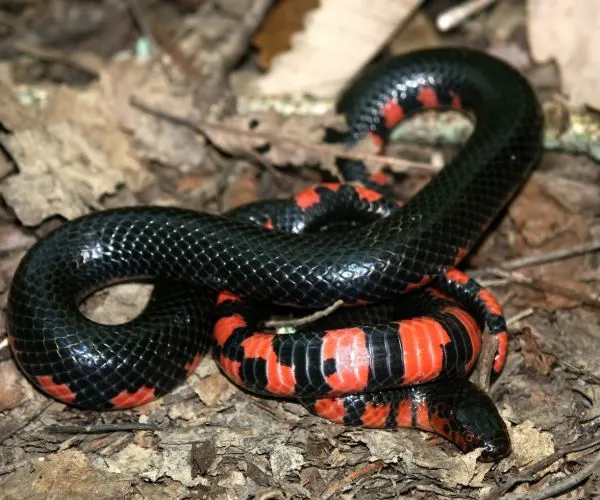
- Experience Level: Intermediate
- Family: Colubridae
- Scientific Name: Farancia abacura
- Other Names: Red-bellied Mud Snake, Redbelly Mudsnake
- Adult Size: 40 to 54 inches; 3 to 6 feet
- Lifespan: Unknown
These heavy-bodied, glossy black snakes have a black and red checker pattern on their underside that will reach all the way down to their tails.
Red-bellied Mudsnakes can be found within the Coastal Plain of the Southern United States such as South Virginia and throughout Florida where they inhabit freshwater environments.
They like habitats such as cypress swamps, canals, lakes, rivers, marshes, hardwood bottomlands, and wet prairies. They will typically opt for the more swamp-like, heavily vegetated banks and muddy bottoms of brackish bays.
These carnivores will feed on amphibians and aquatic salamanders.
8. Eastern Hog-nosed Snake
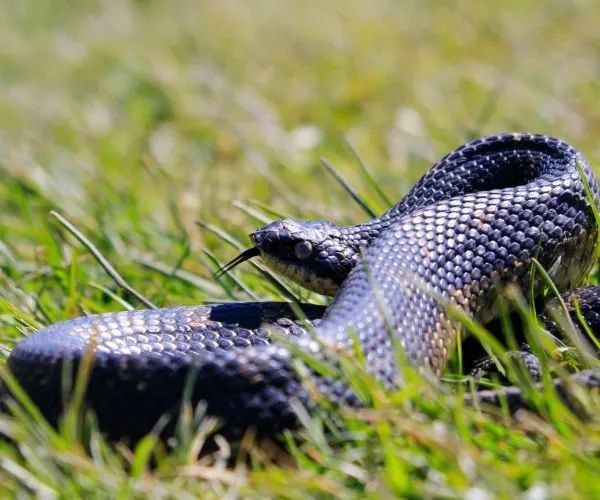
- Experience Level: Beginner
- Family: Colubridae
- Scientific Name: Heterodon platirhinos
- Other Names: Eastern Hognosed snake, Eastern Hognose
- Adult Size: 20 to 33 inches
- Lifespan: 12 years
The Hognose snake is known to be one of the best pet snakes for enthusiasts since they are not fussy and are comfortable with human interaction. They also stay relatively small.
These worm-like snakes have a large, round head with an upward-facing snout, which is what we all love about them. They are dark gray or olive-green, but some are also yellow, tan, or light brown with dark brown spotted patterns on their head and sometimes their bodies.
They prefer to inhabit sandy woodlands, farmland, coastal areas, and fields where they feed on frogs, salamanders, invertebrates, birds, and small mammals. They can use their hog-like nose to get into their prey’s burrows more easily.
9. Yellow-bellied Kingsnake

- Experience Level: Beginner
- Family: Colubridae
- Scientific Name: Lampropeltis calligaster
- Other Names: Prairie Kingsnake
- Adult Size: 30 to 40 inches
- Lifespan: 23 years
This species is typically tan or brownish grey, sometimes with a tint of green-grey and numerous dark brown, copper-colored, or green-brown blotches down their back.
They also have a tan or pale yellow underside and a V- or U-shaped marking on their head.
They can be found in the Southeastern United States, ranging from Maryland to Florida and Nebraska to Texas.
They enjoy habitats with open grasslands that have dry, loose soil near permanent water sources. An example of this type of habitat can include forest edges.
Yellow-bellied Kingsnakes typically feed on rodents, but will also consume amphibians, lizards, birds, their eggs, and even other snakes.
When they are feeling defensive, they will shake their tails in a similar manner to a rattlesnake. They may also release musk and flatten their heads in a defensive stance, but don’t be fooled because they will typically not try to bite anyways.
10. Common Kingsnake
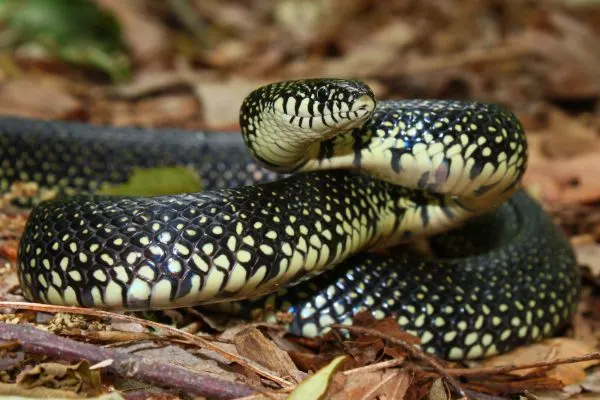
- Experience Level: Beginner
- Family: Colubridae
- Scientific Name: Lampropeltis getula
- Other Names: Eastern Kingsnake, Kingsnake, Chain Kingsnake
- Adult Size: 60 inches
- Lifespan: 25 years in captivity; 5.5 years in the wild
Kingsnakes come in many different patterns, varying from black to dark browns, with pale yellow or white spots, rings, bars, bands, or stripes. They have smooth scales to show off their vibrant colorations and chain-link pattern.
They can inhabit various types of habitats but are mostly spotted in grasslands, forests, rocky fields, and deserts. They might also be found near swamps or riverbanks now and again.
Kingsnakes mainly feed on rodents, lizards, birds, and their eggs. In wetter climates, they might consume amphibians and turtle eggs as well.
11. Milksnake
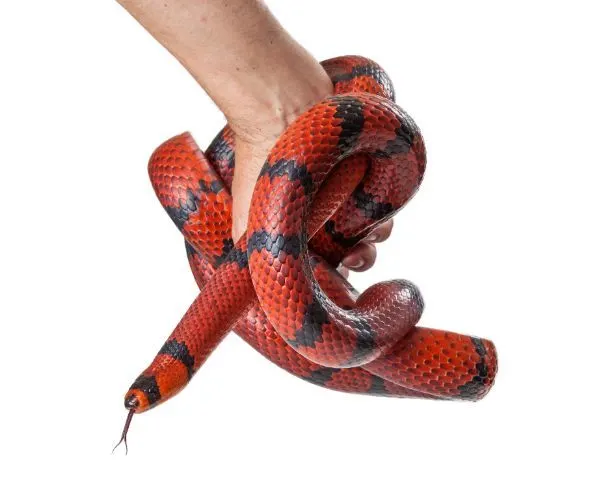
- Experience Level: Beginner
- Family: Colubridae
- Scientific Name: Lampropeltis triangulum
- Other Names: Eastern Milksnake, Eastern Milk Snake, Milk Snake
- Adult Size: About 4 feet
- Lifespan: 22 years
Milk Snakes are a species of Kingsnake that are non-venomous, friendly, docile, and beautiful to look at.
Milksnakes are tan or brown with black-brown bands and blotches that loop around the length of their body. Their skin can sometimes be a pale yellow with almost a red striped pattern, similar to the Western Milk Snake and the venomous Coral snake or a Rattlesnake, depending on the Milk Snake.
They have cat-like pupils that can look intimidating but lack the rattle at the end of their tails.
They can be found in meadows, pastures, under any artificial cover, by the edges of watercourses, by mountain cliffs, and woodlands. These carnivorous snakes feed on lizards, reptile eggs, birds and their eggs, mice, and sometimes insects.
12. Coachwhip
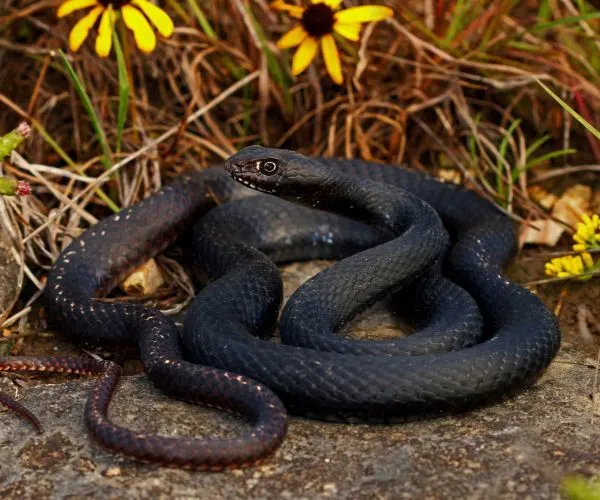
- Experience Level: Expert
- Family: Colubridae
- Scientific Name: Coluber Masticophis flagellum
- Other Names: Whipsnake
- Adult Size: 5 to 8 feet
- Lifespan: 16 to 20 years in captivity; Wild lifespan: 13 years
Coachwhips are thought to be some of the quickest snakes in America.
Coachwhips are fairly slender with distinctive black or dark brown head and ombre colorations with lighter browns and tans down their backs toward their tail.
They have large eyes, which give them great vision as they swiftly sweep the terrain for prey.
You can find them in any dry terrain such as prairies, farmlands, deserts, shrublands, juniper grasslands, creek valleys, and chaparral. You might also find them roaming around agricultural areas with vegetation.
They eat a diet of mainly rodents, frogs, lizards, birds, and their eggs, spiders, and even small venomous snakes. They are also known to eat rattlesnakes if they happen to cross paths with one.
13. Mississippi Green Water Snake

- Experience Level: Intermediate
- Family: Colubridae
- Scientific Name: Nerodia cyclopion
- Other Names: Green Water Snake
- Adult Size: 30 to 45 inches
- Lifespan: 9 years in captivity; Unknown in the wild
Mississippi Green Water Snakes are semi-aquatic, dark green-brown with distinctive scales and dorsal markings on some individuals. Their undersides are dark grey with cream or pale yellow half-moons.
You can find them roaming along the Mississippi River valley and coastlines. They might also be found along the Gulf of Mexico, Illinois, Texas, and Florida.
They will typically choose to live in calmer waters like lakes, swamps, marshes, and ponds. The only brackish waters they might be found in are in the waters along the gulf coast.
They will typically feed on fish just like all water snakes but they will also eat amphibians and crayfish.
14. Plain-bellied Watersnake

- Experience Level: Beginner
- Family: Colubridae
- Scientific Name: Nerodia erythrogaster
- Other Names: Plain-bellied Water Snake, Plainbelly Water Snake, Blotched Snake
- Adult Size: 30 to 48 inches
- Lifespan: Up to 10 years in captivity; wild lifespan unknown
The Plain-Bellied water snake is large, hefty, and solid in color. They will usually be green-gray, solid gray, brown, olive green, or just black in color. They can be distinguished from other water snakes by checking for their unmarked, or plain, underside which might be pale yellow or red.
They like to live in forest edges, ponds, lakes, streams, and bays where they eat fish, crayfish, tadpoles, amphibians, and salamanders.
15. Southern Water Snake

- Experience Level: Beginner
- Family: Colubridae
- Scientific Name: Nerodia fasciata
- Other Names: Broad-banded Water Snake
- Adult Size: 22 to 36 inches
- Lifespan: 9 years
These rough, dark grey or black snakes have almost brown-red copper-like “burn marks” or blotches along their backs and sides. It almost looks like spilled coffee on a black canvas and their underside is pale yellow or tan.
These watersnakes can be found along the southeastern Coastal Plain of the United States in regions stretching from Alabama to North Carolina. They can also be found in Indiana, Louisiana, and Florida.
They choose to make homes out of freshwater marshes, ponds, streams, lakes, rivers, and swamps.
They feed on aquatic prey such as fish and amphibians.
16. Diamondback Water Snake

- Experience Level: Intermediate
- Family: Colubridae
- Scientific Name: Nerodia rhombifer
- Other Names: Diamondback Watersnake
- Adult Size: 3 to 5 feet
- Lifespan: 9 years
Diamondback Watersnakes are mostly brown or olive green with a black almost net-like, diamond-shaped pattern, which is where they get their names.
You can find them in the central United States or in the northernmost parts of Mexico. They can also range within a lot of southern states such as Oklahoma, Kansas, Arkansas, Missouri, Illinois, Tennessee, Mississippi, Alabama, Georgia, Iowa, Louisiana, Oklahoma, and Texas.
They inhabit aquatic settings such as lakes, marshes, ponds, rivers, streams, canals, creeks, ditches, and swamps.
They frequent shallow waters looking for amphibians, carrion, and slow-moving fish. They are nocturnal hunters and prefer to feed in warmer weather.
17. Northern Watersnake
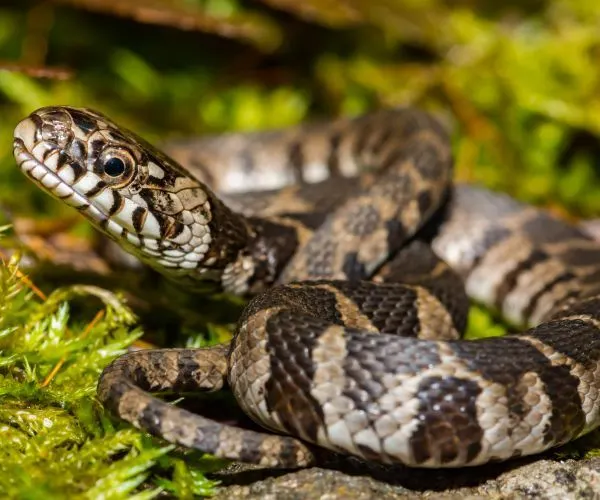
- Experience Level: Beginner
- Family: Colubridae
- Scientific Name: Nerodia sipedon
- Other Names: Watersnake, Common Watersnake
- Adult Size: 24 to 55 inches
- Lifespan: 9 years
Northern Water Snakes are popular pets since they do not require much effort and are relatively safe, even around children. They can also grow fairly large in size.
They are usually dark in color, ranging from brown, tan, to gray, and have keeled scales. They also have square blotches on their backs and sides that may alternate or become bands throughout their length.
Water Snakes typically live in or near aquatic habitats which is why they are called water snakes. They like to bask on rocks by still or slow-moving water such as seasonal pools, lakes, and ponds.
You might see them swimming and hunting the waters as well.
They like to eat fish and amphibians, swallowing them whole and alive. They eat all kinds of fish species such as smallmouth bass, minnows, bullhead catfish, hogsuckers, sunfish, and brook trout.
18. Rough Greensnake
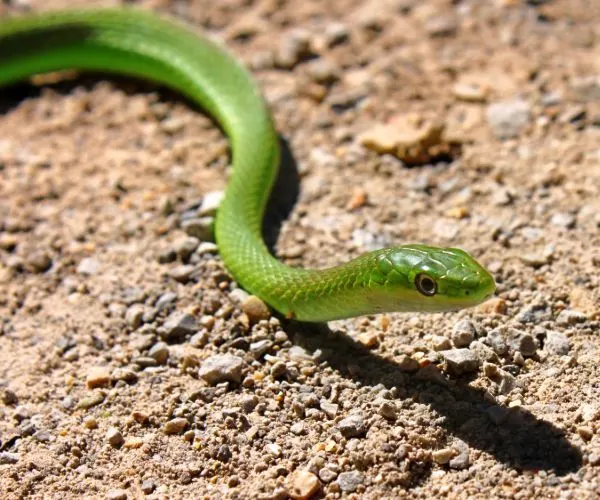
- Experience Level: Beginner
- Family: Colubridae
- Scientific Name: Opheodrys aestivus
- Other Names: Green Snake, Grass Snake, Rough Green Snake
- Adult Size: 2 to 3 feet
- Lifespan: 8 years in captivity; wild lifespan unknown
Rough Green Snakes remain healthy in population and can make great diurnal pets for someone who is more of an observer. They don’t really like being handled and prefer sitting in their enclosure.
They are docile beings and will rarely ever try to bite, if at all.
These green snakes look very similar to their cousins, the Smooth Green Snake, with totally lime green bodies and cream-colored undersides. However, if you want to know the differences between these two, it lies in their scales.
Smooth Green Snakes do, indeed, look smoother due to their flat, shiny scales whereas Rough Green Snakes have more raised scales with keels on the scales covering their dorsal and sides. They will also have larger eyes than their “smooth” counterparts.
These green snakes love to live among the vines, shrubbery, and leaves of trees. They like thick vegetation, lush streamside forests, moist woods, and the gardens in our very backyards.
They usually live off insects like crickets and grasshoppers, but will also consume spiders, small frogs, and snails. They hunt using their large eyes and excellent vision.
19. Pinesnake

- Experience Level: Beginner
- Family: Colubridae
- Scientific Name: Pituophis melanoleucus
- Other Names: Pine Snake, Northern Pinesnake
- Adult Size: 48 to 66 inches
- Lifespan: up to 20 years
This snake might have a light grey, white, yellow, or pale coloration with brown blotching or spots all over.
While their range is a bit patchy, you can find them across the southeastern states such as North and South Carolina, Georgia, Virginian mountains, Tennessee, Georgia, and throughout Florida.
They like to inhabit areas with sandy soils and places like pine woods with dry upland forests.
These powerful constrictors can eat a lot of rodents like gophers, rabbits, rats, and mice. They also prey on terrestrial birds and their eggs when given the chance.
20. Queen Snake

- Experience Level: Beginner
- Family: Colubridae
- Scientific Name: Regina septemvittata
- Other Names: Queen Snake
- Adult Size: up to 24 inches
- Lifespan: over 19 years in captivity; wild lifespan unknown
While these snakes are friendly, docile, and take well to handling, they are listed as an endangered species and protected under the Endangered Species Act by the U.S. Fish and Wildlife Service.
The Queensnake is similar in appearance to the Garter Snake, which causes much confusion when identifying them. They are slender with dark olive or brown bodies with cream or pale yellow stripes along each side of their bodies.
They can be spotted in mountainous regions and sometimes along river drainages. They like to make homes near streams where they hide under rocks and find opportunities to bask in the sun when they can.
They mainly feed on soft, just-molted crayfish without hard exoskeletons.
21. Dekay’s Brownsnake

- Experience Level: Beginner
- Family: Colubridae
- Scientific Name: Storeria dekayi
- Other Names: Brown Snake, DeKay’s Brown Snake
- Adult Size: approximately 13 inches
- Lifespan: 7 years in captivity; unknown in the wild
Brownsnakes are not shy and humans commonly encounter them. They can make great pets for beginners due to their size and gentle nature. They are also quite easy to feed.
These non-venomous snakes are usually brown in color, as their name suggests, but can also come in a yellowish, red, or grayish-brown tone.
They will typically have two rows of either darker or lighter spots which might also be linked, making it look like a collar or middorsal streak down the side of their head. Underneath each of their eyes may also be a small, dark spot.
These markings may also not appear on some individuals.
Their undersides will either be white or tan.
They like to reside in various woodlands, more commonly in wet areas like swamp edges or wetland borders. They like to roam the litters of abandoned fields, lowland hardwoods, prairies, and oak savannas.
They are also often spotted in residential areas or urbanized territories.
In their habitats, they will consume small invertebrates like earthworms, slugs, and snails with their specialized jaws and teeth. They may also eat beetles and salamanders if they come across one.
22. Red-bellied Snake

- Experience Level: Intermediate
- Family: Colubridae
- Scientific Name: Storeria occipitomaculata
- Other Names: Redbelly snake, Red-belly Snake, Copperbelly Snake, Northern Red-bellied Snake
- Adult Size: 8 to 16 inches
- Lifespan: 4 years in captivity; Wild lifespan unknown but predicted to be longer than in captivity
While Red-bellied Snakes are rarely encountered in the state, they still exist in the wilderness. They are just very secretive.
These small snakes can be found in swarms basking in the sun on the warm days of September to October. You can also find them in woodlands, fields, under logs, in forests, bike trails, back roads, and sphagnum bogs.
In these areas, they feed on earthworms, beetle larvae, and slugs.
People can sometimes find them out in their pesticide-free garden or just out in the wild and might want to keep them as a pet. However, they really struggle to eat when in captivity and will sometimes just outright refuse when they are removed from the wild.
They do not do well in captivity and prefer to be free to roam the lands as they please. Although they aren’t hard to obtain in the wild, they might not be the best pet to keep if you are planning to have them for long since they do not do well away from their natural habitat.
Due to this, you might not run into them as often in the wild since they like to stick to their spaces. They are not as tolerant of populated areas.
It’s not hard to identify these snakes since they really do live up to their name with their flashy red or orange undersides. Their bodies might be a dark steel grey, black with a blue tint, or copper brown. Some may also have two dark stripes along their sides or a thick, light-colored band down the middle of their backs.
While they will usually first curl their tails or flee in defense before they try to bite, their little nibble probably won’t affect you anyway.
While they are small and beautiful, this does not mean they will make a good pet since they do not usually survive long in captivity.
23. Southeastern Crowned Snake

- Experience Level: Intermediate
- Family: Colubridae
- Scientific Name: Tantilla coronata
- Other Names: Southeastern Crown Snake
- Adult Size: 5 to 10 inches
- Lifespan: 5 years
Southwestern Crowned Snakes are unpatterned, small, slender, tan, or dark brown snakes with a pale yellow or cream underside.
They can be found in various habitats throughout the Coastal Plain.
They are primarily insectivorous, feeding on snails, spiders, and insect larvae with a preference for centipedes.
24. Western Ribbonsnake

- Experience Level: Beginner
- Family: Colubridae
- Scientific Name: Thamnophis proximus
- Other Names: Ribbon Snake
- Adult Size: around 3 feet
- Lifespan: 10+ years in captivity; wild lifespan unknown
Another Ribbonsnake, which is the most common species of Garter Snakes, is the Western Ribbonsnake. As we mentioned with the Eastern, they have various morphs to pick from and are non-poisonous, making them an attractive pet choice.
Similar to the Eastern, Western Ribbonsnakes can be brown, almost black, or olive-colored with their signature pale yellow or light green stripes along their bodies.
Ribbonsnakes are semi-aquatic and can be found near a water source like the shorelines of rivers or lakes. They will sometimes inhabit water edges near forests or wetlands.
They are carnivorous and mainly feed on small fish, insects, and tadpoles.
25. Common Gartersnake

- Experience Level: Beginner
- Family: Colubridae
- Scientific Name: Thamnophis sirtalis
- Other Names: Garter Snake
- Adult Size: 23 to 30 inches; some can grow up to 5 feet
- Lifespan: 4 to 5 years in the wild; up to 10 years in captivity
Common Garter Snakes are completely harmless to humans.
These guys are usually relatively small and like to remain active during the day. These guys like to soak often, so they will require a bowl in their tank for them to soak in, especially when it comes time to shed.
Garter snakes are great snakes for beginners since they are docile and will not grow to be too large.
Common Garter Snakes can range from dark olive-green to brown or black with a distinctive yellow stripe running throughout the length of their body.
When threatened, they may let off a musk in order to ward off predators. They can be found in many places like marshes, woodlands, meadows, or hillsides.
These snakes feed on leeches, slugs, worms, small fish, amphibians, and even other snakes. They are also immune to toxic frogs that secrete toxins from their skin in order to drive away prey.
26. Rough Earthsnake

- Experience Level: Intermediate
- Family: Colubridae
- Scientific Name: Haldea striatula
- Other Names: Brown Ground Snake, Ground Snake
- Adult Size: 7 to 10 inches
- Lifespan: 7 years in the wild; significantly less in captivity
These tiny snakes might be super tempting to take into your care if you find one outside, but they really do not take well to captivity and will typically die very quickly. It is best to let them stay in their wild natural habitat.
Rough Earth Snakes are small, worm-like, brown-grey snakes with a tan or cream underside and tiny, beady eyes.
These tiny, worm-like snakes are endemic to many states from Virginia, Florida, the Gulf Coast, Texas, Missouri, and Kansas.
Rough Earth Snakes like to live in forested habitats or any areas that have rocks, leaf litter, compost piles, logs, and any other ground coverage for them to hide under. They can be found in a variety of different areas including urban habitats.
They feed almost exclusively on earthworms, but will also eat other invertebrates such as snails, slugs, larvae, and insect eggs.
27. Smooth Earthsnake

- Experience Level: Intermediate
- Family: Colubridae
- Scientific Name: Virginia valeriae
- Other Names: Western Smooth Earth Snake, Western Ground Snake
- Adult Size: 7 to 19 inches
- Lifespan: Unknown; Shorter in captivity
Western Ground Snakes are on the smaller side and can range from light browns to greys or even a copper-like color. Their undersides are typically cream or off-white and they do not have any distinctive markings.
They are endemic to North America and have many different subspecies that might variate in coloration or patterns depending on their geographical region.
They like to live in habitats that are warm and humid. They prefer woodlands, moist woods, or woody hillsides where they can be found hiding under rocks and leaf litter.
They are nocturnal and like to hunt at night. These snakes feed on soft-bodied insects such as earthworms and slugs.
Venomous Snake Species in Tennessee
Here is a list of the most venomous snakes that roam the state:
28. Copperhead

- Experience Level: Expert
- Family: Viperidae
- Scientific Name: Agkistrodon contortrix
- Other Names: Highland Moccasin, Eastern Copperhead, Copperhead Snake
- Adult Size: average 2 to 3 feet; up to 4 feet
- Lifespan: 18 years
Copperheads aren’t aggressive towards humans unless provoked, which is why bites from them are somewhat rare, even in areas that they have been spotted.
These large snakes are tan in color with copper or rusty-looking, chestnut, blotches all throughout their bodies which look like spilled coffee spots. These pit vipers have a distinctively triangular-shaped head.
They can be found in a variety of environments anywhere from semiaquatic to terrestrial. This includes wetlands, hillside forests, rocky areas, and abandoned construction sites in the suburbs where they can find rotting wood or piles of sawdust.
These snakes are carnivorous, eating mostly small rodents like mice. They also consume other smaller snakes, lizards, insects, amphibians, and birds.
They do their hunting by ambushing their prey, injecting them with venom, then swallowing it whole.
29. Cottonmouth

- Experience Level: Expert
- Family: Viperidae
- Scientific Name: Agkistrodon piscivorus
- Other Names: Water Moccasin
- Adult Size: 4 feet
- Lifespan: 10 years
These can be found in the Coastal Plain but can also be found throughout Piedmont of Atlanta, Georgia.
They prefer moist habitats like marshes, swamps, roadside ditches, streams, lakes, and retention ponds.
They feed on small mammals, birds, lizards, amphibians, fish, crayfish, insects, turtles, and even other snakes.
30. Timber Rattlesnake

- Experience Level: Expert
- Family: Viperidae
- Scientific Name: Crotalus horridus
- Other Names: Canebrake Rattlesnake, Banded Rattlesnake
- Adult Size: 6 feet
- Lifespan: Anywhere from 10 to 30 years in the wild; 30+ years in captivity
Rattlesnake bites are very serious and should be treated as a medical emergency. However, they are also somewhat timid creatures, meaning they are not often spotted.
These vipers are usually gray or yellow-brown in color with dark brown blotches all or bands throughout their body and a brown, yellow, or copper stripe running down the length of their back.
They can generally be found in bluffs, croplands, rugged deciduous forest terrains, rocky ledges, and dense woodlands with closed canopies. They like to move around during different seasons and females will move to rocky terrains when they are pregnant for higher temperatures.
Timber Rattlesnakes feed mainly on smaller mammals but will also eat the occasional bird if they feel like it.
31. Pygmy Rattlesnake

- Experience Level: Expert
- Family: Viperidae
- Scientific Name: Sistrurus miliarius streckeri
- Other Names: Western Pygmy Rattlesnake, Dusky Pygmy Rattlesnake
- Adult Size: 16 to 25 inches
- Lifespan: 6 to 15 years
These light grey or tan snakes are thick-bodied with a line of black dots alternating with a brown or reddish-orange stripe along with the spots. Their undersides are typically offwhite with dark spots.
They can be found across the western to the eastern United States like Mississippi, Louisiana, Texas, Oklahoma, Missouri, Arkansas, and Tennessee.
They inhabit environments that are near water such as marshes, swamps, and creeks, but can also be found in mixed pine and hardwood forests, pine and oak sandhills, scrub pine woods, swamps, and xeric uplands.
Typically, these carnivores will feed on terrestrial vertebrates, insects, reptiles, amphibians, and mammals.
Conclusion
If you live in Tennessee or are curious as to what snakes might roam this large state, we hope our list did you justice.
There are tons of interesting species to check out and many that can be kept as pets as well.
Let us know in the comment section below about your thoughts or leave any questions you might still have.
Other nearby states with snakes
- Snakes in Alabama
- Snakes in Arkansas
- Snakes in Kentucky
- Snakes in North Carolina
- Snakes in Mississippi
- Tennesse Water Snakes
- Water Snakes in Virginia
References
https://www.tn.gov/twra/wildlife/reptiles/snakes.html
https://www.animallaw.info/statute/tn-exotic-pet-part-4-exotic-animals
https://www.mtas.tennessee.edu/knowledgebase/exotic-animals-law-tennessee
